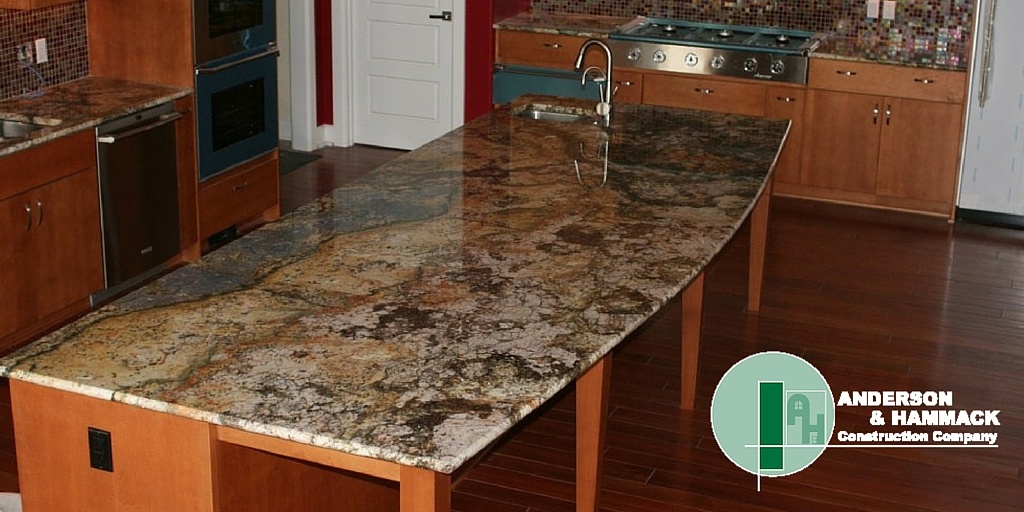Which counter top is the right material for your project?
There are numerous types of surfaces available for counter tops, each having strengths and weaknesses. While one material may be similar in cost to another, choosing the right surface for your lifestyle can be the key between maximizing the utilization of the room, loving the room, and wishing you had done something different. Don’t fall into the trap of watching a show on HGTV and assuming their recommendations for surfaces matches your lifestyle.
In this article, we will compare counter top materials, allowing you to:
- Make a better surface material choice, based on how you plan on using it.
- Share an unbiased view of the material, relating to it’s strengths and weaknesses.
- View relevant articles from leading contributors regarding these materials.
- What People Are Using For Countertop Materials
There are numerous types of materials people are using today for counter tops. In this article, we will compare quartz, granite, marble, recycled glass, concrete, butcher block, stainless steel, laminates, tile, solid surfacing, ultracompact, soapstone, limestone, and bamboo.

Quartz Countertops
Made from one of the hardest minerals on earth, quartz countertops are arguably the most durable option for kitchens. They’re also some of the most eye-catching. They come in a wide variety of colors, including fire-engine red and apple green, as well as earthy browns, blacks, and creams, with sparkles and veining for the look of granite or marble. But unlike natural-stone slabs, which are mined, these slabs are engineered in a factory. Their primary ingredient is ground quartz (about 94 percent), combined with polyester resins to bind it and pigments to give it color. For some designs, small amounts of recycled glass or metallic flecks are added to the mix. The resins also help make these counters stain and scratch resistant—and nonporous, so they never need to be sealed. Compare that with granite, the reigning king of high-end countertops, which typically requires a new protective top coat at least once a year.
In the past, the biggest knock against quartz was that it lacked the patterns and color variations you get with natural stone. But that’s a moot point now, with all the manufacturers offering multihued slabs with enough flecks, swirls, and random patterning to make them almost indistinguishable from the real thing. They were once available only with a polished finish; now you can get one with a honed, sandblasted, or embossed treatment. So if it’s the look of matte limestone, textured slate, or glossy granite that you want, there’s a quartz countertop for you.
Pro’s
Quartz survives a gauntlet of spills, hot pots, knives, and more with top scores, and it doesn’t have to be sealed for stain protection. It’s waterproof so it can be paired with an under-mounted sink.
Con’s
Some patterns can appear unnaturally uniform, although manufacturers are trying for a more random look closer to natural stone. Edges and corners can chip and only a pro can repair them–rounded edges help.
Download Our Free Countertop Comparison Guide Here
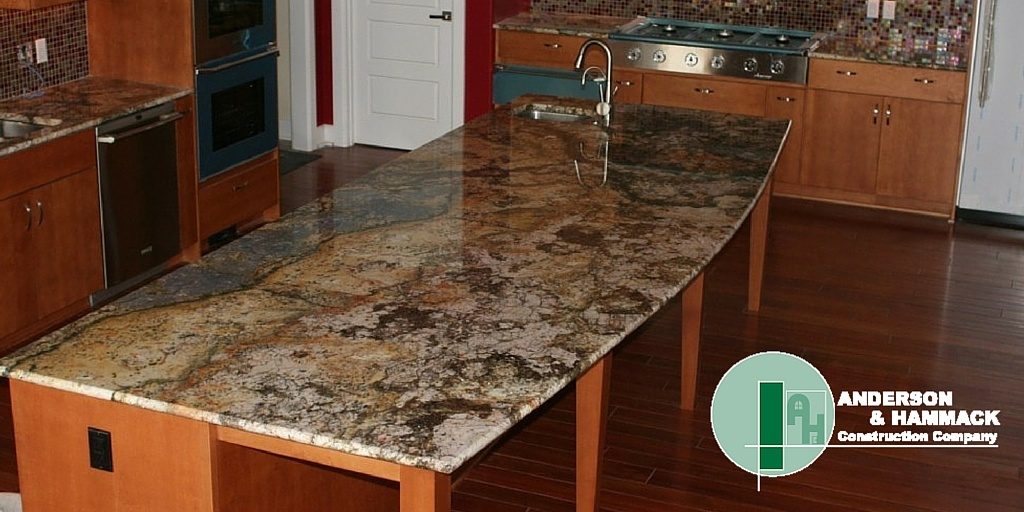
Granite Countertops
Granite is a naturally occurring stone. Mainly igneous rock, it is formed by the crystallization of molten rock and undergoes huge amounts of heat and pressure over time. Several different types are sold commercially including other volcanic-origin stone sold as “granite”:
- True granite
- Pegmatite
- Syenites
- Diorite
- Larvikytes (labradorite)
Favored above many other stone countertops, granite is valued for its resistance to acids and its hardness. It is a porous stone and can be stained or damaged if not sealed before use.
On the other hand, tiles are easier to work with because they are smaller and lighter. They come precut and perfectly square. You can pick from several different shapes and measurements.
The main difference between slab and tile are the seams. Tiles obviously have many seams or grout lines. Slabs generally have seams unless your get a slab large enough for your entire counter. But slabs have far less seams than tiles.
GRANITE CARE
Granite countertops in your bathroom or kitchen will last a long time and look great with the right care. They maintain their polished surface and look new even a decade later.
Sealing
After your countertop is installed, protect it with a sealer. Sealing it doesn’t make it impervious, but it does help it repel stains and resist cloudiness or scratches. Ensure that the counter has been dry for at least 6 hours then apply a liquid or spray sealer, let sit for 30 minutes and wipe the excess with a soft, clean cloth. You can apply a second coat 24 hours later if you desire. Reseal your countertops about every two years.
Daily Care
Granite is porous so it’s a good idea to keep counters as dry as possible. Use coasters under drinks-especially drinks with alcohol or citrus juice-and clean up spills promptly. Do not place hot items directly on the countertop. Clean countertops with a non-abrasive, neutral cleaner. You can buy stone soaps or simply use a mild dishwashing detergent. Rinse it and dry well to avoid streaks. Keep acid and abrasive materials away from your granite.
Polishing
A couple times per year you’ll want to polish your granite countertops so they remain smooth and reflective. Use a granite polishing compound and apply with a clean, soft cloth.
Pros
Like quartz, granite survives spills, hot pots, knives, and more with top scores.
Cons
Edges and corners can chip and you’ll need a pro to repair them, and granite needs periodic sealing for stain protection.
Download Our Free Countertop Comparison Guide Here
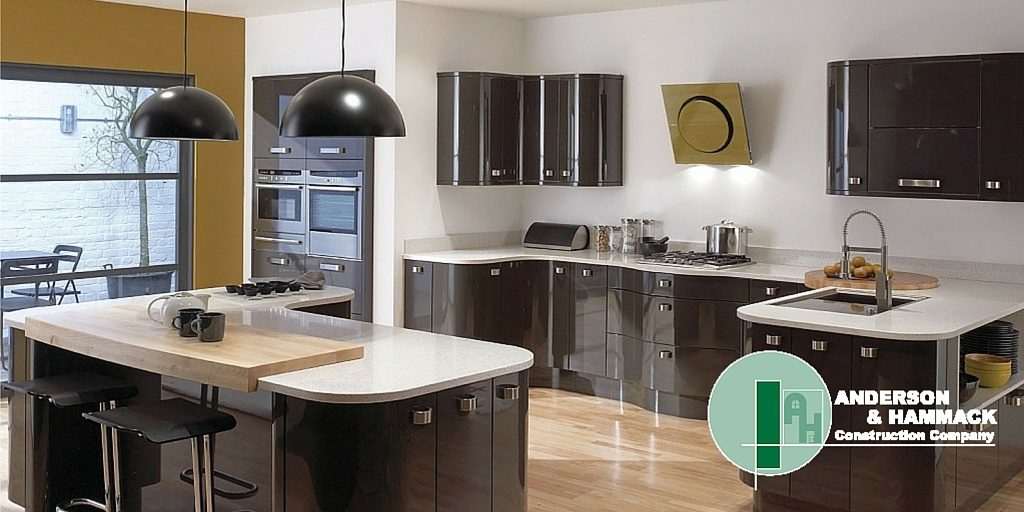
Marble Countertops
Marble is a luxurious surface that lends warmth and sophistication. Its price tag, comparative softness and susceptibility to stains mean it’s not always used throughout the kitchen. Instead, many homeowners choose to install it on an island or separate baking center to both lower the cost and reduce wear and tear. Rich with crystals and color variations, marble comes in a variety of shades, including white, cream, black, green and pink.
What is it? Marble is a metamorphic rock (was once one form of rock but has changed to another) containing crystallized limestone.
Considerations When Choosing Marble Countertops
Thickness, Overhangs and Edges. Countertop thickness ranges from a three-quarter inch to an inch and a quarter (preferred). Standard overhang is one inch to an inch and a half. Edge options range, though straight remains the most popular.
Marble Types
Carrera is a white or blue-gray marble with soft veining. It lends old-world charm.
Calacatta/Calcutta is white with more distinctive taupe veining.
Forms
Marble counters can come as slabs or tiles. Slabs. Marble slabs offer a solid and seamless look. If your counter is curved or arched, a seam will be required. Tile. If you love the look of marble but find its cost prohibitive, consider more affordable marble tiles. An added benefit: You can save the excess tiles after installation is complete, and in the future, if the countertop becomes stained, the damaged tile can be replaced.
Care and Maintenance
When it comes to keeping marble countertops looking new, a little prevention goes a long way: Place trivets under hot pots and pans, set coasters under glasses, use cutting boards when slicing food and wipe up any spills immediately. Marble is prone to etching, so be especially careful with acids—that means pour orange juice carefully and don’t wipe down the counters with vinegar. Wipe the countertop with a soft cloth and warm water daily. Mild household cleansers are suitable, but you can also find cleaning products specific to marble. Certain oils and acids can stain. Marble should be resealed periodically.
In general, embrace the patina and minor imperfections marble countertops gain over the years.
The Bottom Line
Marble is a luxurious surface that lasts a lifetime. While pricey and not the most durable choice, the smooth and cool surface is an excellent choice for a baking center or pullout slab.
Pro’s
Small nicks and scratches can be polished out.
Con’s
Marble chips and scratches easily and you’ll need to seal periodically to protect from staining. Most stains that marred unsealed marble wipe away with water on sealed surfaces, but hard-water deposit removers leave a permanent mark, even on sealed stone.
Download Our Free Countertop Comparison Guide Here
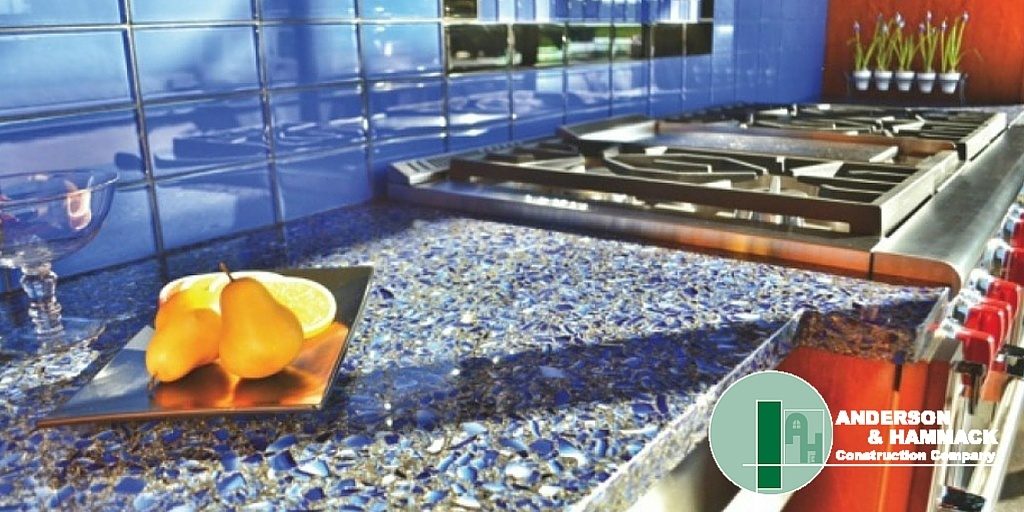
Recycled Glass Countertops
With so many options for countertops available on the market, deciding on a relatively new product like recycled glass can be a challenge. These unique counters have some advantages over other materials, however, which can help make your decision easier.
Sustainability
Recycled glass is one of the only truly sustainable countertop options available today. Stone counters like granite must be cut from the earth and cannot be replaced. Quartz, solid-surface, and laminate countertops that are produced from man-made materials often give off high levels of VOCs (Volatile Organic Compounds) during production mostly (Depending on Manufacturer), or are made from non-renewable resources, making recycled glass one of the only green building options available for counters.
Durability
Recycled glass counters do not scratch, melt, burn, chip, or stain. They require no maintenance; clean them with your favorite products on your timetable. Unlike granite or stone counters, they do not require sealing or special cleaners, and unlike solid-surface or laminate counters, they don’t show wear over time. In durability, the only product comparable is quartz, which sometimes has high levels of VOCs (Depending on Manufacturer). An example of manufacturer VOCs data for quartz can be found here.
Beauty
Glass counters are a completely unique product. The exact mix of glass particles changes subtly with each slab, making each countertop’s design exclusive to the buyer. The pieces of glass suspended in the counter may be dull, polished, jagged or smooth, as well as varied in color and size, making each counter a work of art.
Pro’s
Best for a contemporary look when it’s made with large shards, or it can resemble solid surfacing when the glass is finely ground. Resistant to heat, cuts, and scratches.
Con’s
But chips and stains can be a problem. Heating the surface can create small cracks, which are nearly impossible to repair.
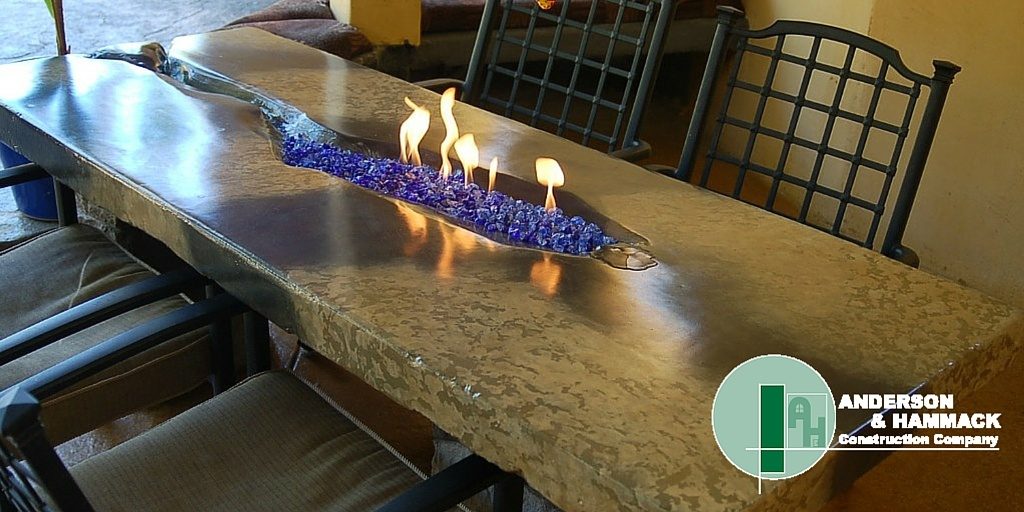
Concrete Countertops
You might think concrete is better suited for sidewalks, but the truth is that one-of-a-kind concrete kitchen countertops can create a unique cooking space. Concrete countertops work well in kitchens ranging from modern to rustic, making them a versatile option for a number of kitchen designs.
Concrete can be formed with an “organic,” natural feel, with a down-to-earth quality that is not common to stainless steel, laminate or other synthetic countertops. Each concrete countertop is handmade. If you know how to stain concrete, the countertop can incorporate almost any color. Textures, and even patterned imprints like floral designs, can also be added. Concrete countertops can also be embedded with stones, seashells and other items that interest you.
These countertops are also fairly eco-friendly, making them an appealing choice to homeowners focused on environmental issues. Concrete countertops can even incorporate recycled glass, wood chips and other repurposed materials.
Maintenance is fairly easy; concrete countertops should be waxed every six months and sealed annually. Certain food and drink products, like lemon juice, wine, ketchup and other dye-heavy items can stain concrete countertops, so be sure to clean spills immediately to avoid staining.
Pro’s
Concrete can be tinted and textured and can include stone chips.
Con’s
It chips and scratches easily and can develop hairline cracks. Topical sealers can protect against stains but not heat; penetrating sealers can handle heat, but not stains.
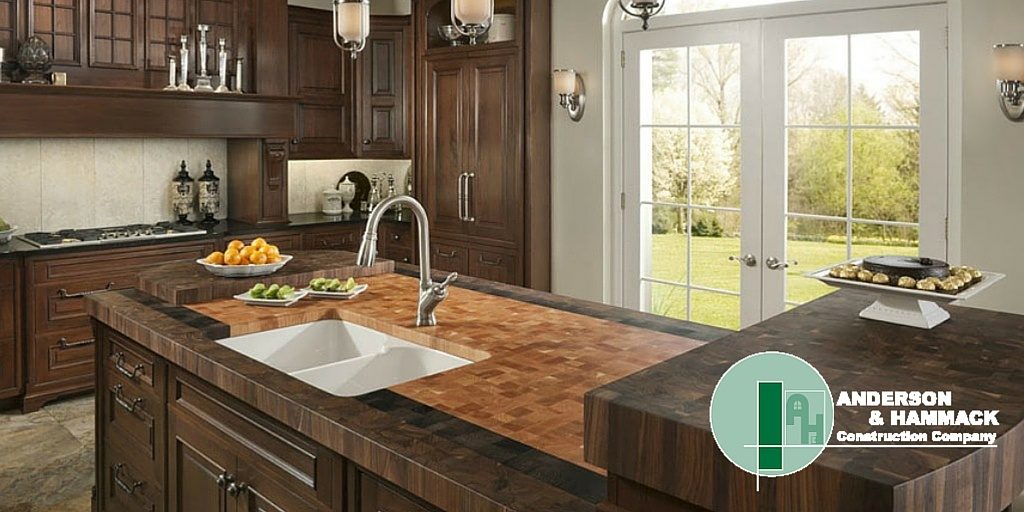
Butcher Block Countertops
There are three basic construction styles of butcher block: edge grain, flat grain, and end grain.
Edge grain is the one most commonly used for counters because it’s strong, stable, and less expensive than the others. It’s made by placing long boards on their sides and joining them so that their long narrow edges form the surface. The boards can be continuous lengths of wood with no joints, or random-length boards that are finger-jointed (as shown above).
Flat-grain butcher block is constructed from boards that are laid flat, their full widths forming a surface with a streamlined look. Susceptible to marks when used for chopping and cutting, flat grain is less suitable for working kitchen counters than the others.
End-grain construction is made from small rectangular blocks arranged so that the ends (with growth rings showing) are visible on the surface. The strongest and most expensive type of butcher block, it’s great for surfaces dedicated to cutting, because it camouflages knife marks and is gentle on blade edges (they slide into the grain rather than against it).
Butcher block can be made from nearly any wood. Maple is one of the best and most popular for butcher block counters because it’s hard and has a clear grain. Cherry and red oak offer rich color. Butcher block can also be crafted from bamboo (it works best with end-grain construction) and sustainably farmed exotics such as wenge and zebrawood.
For kitchen counter applications, it’s important to use unsealed, oil-finished wood. Sealed countertops are not meant to be used as food-prep work surfaces—they’re not food or knife friendly. Using sealed wood defeats the purpose of butcher block, because it covers up the natural warm surface with plastic. Sealed butcher block does offer shine and can work well as a work desk or bar top in a kitchen that doesn’t involve food. (And when needed for food prep, pair it with a cutting board.) Note that unsealed butcher block is not recommended immediately around a sink: Over time it will likely discolor and rot.
Maintenance
At a minimum, butcher block countertops require oiling every six months to keep the wood protected. Different woods come with different finishing oil recommendations and it’s best to follow the instructions of your installer. Depending on level of use, butcher block may also require more frequent oiling and conditioning to prevent the wood from cracking and looking dull. N.B.: Avoid using cooking oil to treat butcher block; it can damage the wood. Because butcher block is soft, it mars more than other materials—leading some people to use it for certain surfaces only, such as work islands. Just before oiling, you can lightly remove scratches, burns, and other surface damages with fine sandpaper, and your countertop will look like new.
Pro’s
This material is useful for food preparation such as chopping and slicing. It’s relatively easy to install and repair.
Con’s
Damage from heat, cuts, scrapes, and impacts make for high maintenance. Butcher block countertops must be treated regularly with mineral oil or beeswax. Varnished butcher block is extremely stain-resistant, but terrible at everything else. Butcher block with an oil finish is better at resisting heat, but stains spread and are impossible to remove. Fluctuations in humidity affect wood, making butcher block a poor choice for over a dishwasher or around a sink.
Download Our Free Countertop Comparison Guide Here
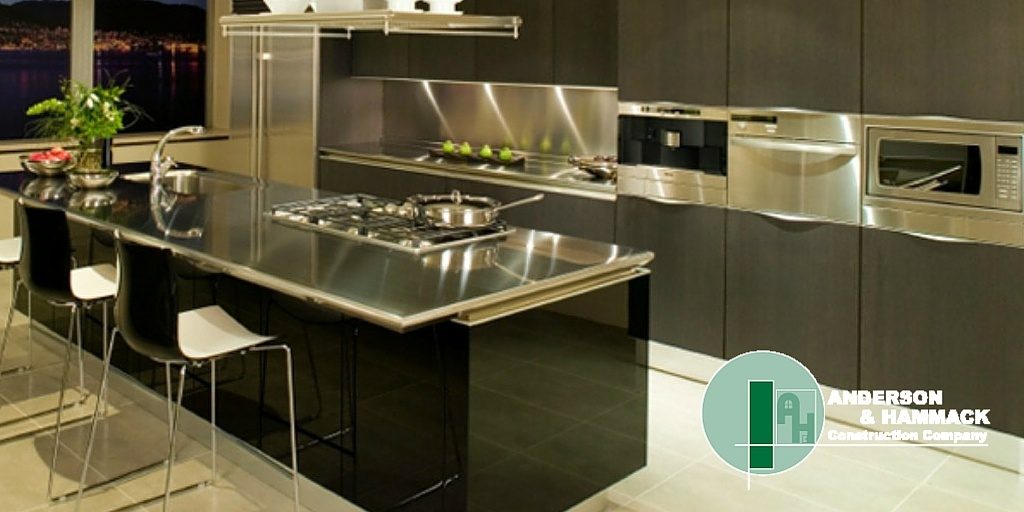
Stainless Steel Countertops
Not only are steel counters aesthetically pleasing but they’re resistant to water, heat, stains and just about anything else! Stainless steel has a non-porous surface, which means that no type of liquid or substances can penetrate into the material at all. Bacteria, mold and other common household germs don’t stand a chance with stainless. You are being given the opportunity to enjoy a completely hygienic surface for preparing meals as long as you practice regular cleaning habits.
You don’t have to fear oils, beets, acids, wine, grape juice or even working with food coloring any longer. This countertop does not stain. This makes it perfect for families with young children that are aspiring chefs and love to work alongside mom and dad to prepare the evening meal. When accidents happen you can put your worries aside as a parent and simply clean up the counter without a second thought about any stains setting in.
As far as heat goes, feel free to put all of your pans and pots down without having to worry about any damage occurring. The countertop will heat up in the area where the pot is placed, but this heat doesn’t travel along the length of the counter. As an added bonus, your countertop will stay cool during the hot summer months.
An elegant tailored look
These worktops are custom-made to perfectly fit your kitchen. You’ll end up with a tailored and elegant countertop that looks absolutely perfect once it has been laid down. The metal is flexible enough to make it a joy to work with. You can come up with interesting designs for your countertop and may opt to incorporate a backsplash with it. Many people also have a counter that is made complete with sink attached. This makes cleanup a breeze since there doesn’t have to be any edges between the sink and the counter.
Perfect for contemporary kitchens
Steal offers a distinctive feel and look that blends perfectly into modern contemporary kitchens. When you need something sleek with a shiny modern look to it, look no further than stainless countertops. Because the metal is also neutral in color, it can be used in any type of kitchen. Even the most traditional kitchen decor can accept a stainless steel counter without a problem.
Pro’s
Resistance to heat and stains is a plus.
Con’s
Steel dents and scratches easily and shows fingerprints. Drain cleaners and hard-water deposit removers can discolor steel.
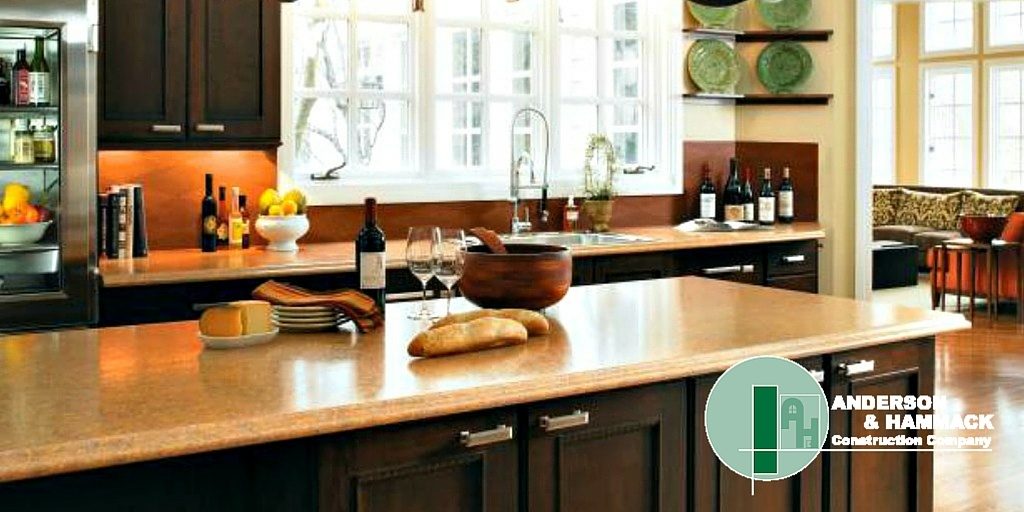
Laminate Countertops
Laminate countertops obviously aren’t new. But just because they’ve been around a while doesn’t mean they’re still the ho-hum countertops they used to be. Laminate still retains all of its good character traits like low cost, ease of maintenance and gobs of color choices. But today there are new textures and lots of new patterns that more closely mimic natural materials.
If that’s not enough, there are a number of different edge treatments you can choose that eliminate the dreaded ‘dark line’ seams. Laminate countertops prove once again that you can teach an old dog new tricks.
The longevity of laminate countertops within the marketplace might lead you to think there’s not much more to learn about them. If you’re a kitchen designer, you may be right. But if you’re reading this page something’s given you the inclination to check them out a little further.
Laminate is pretty basic, but there are some things you should know about so you don’t overlook a product that might be right for your kitchen.
What Is It? Laminate is a combination of paper and resin that is pressed and bonded or “laminated” together under high pressure and heat. The result is a product that is reasonably durable and easy to maintain.
To bore you with a few more facts, laminate is typically constructed in three layers. The bottom layer is made from kraft paper (the same paper that grocery bags and mailing wrap are made from) which is soaked in a phenolic resin. (Kraft paper is usually brown which results in those dark brown edges.) The middle layer contains the print or color/pattern that you actually see. This is followed by a clear top layer which may be topped with some abrasion-resistant materials. The middle and top layers of laminate are impregnated with melamine which is a clear resin. Some laminate countertop products use other materials on the top surface to increase the wear resistance.
So why is this important? Just like with any product, knowing the kind of material you’re dealing with might help you understand what it will and won’t stand up to. Remember that it’s basically a plastic so it has some limitations particularly with regard to heat and some caustic chemicals. Also, the color or print on that middle layer of paper is susceptible to fading over time from UV light just like other fabrics and colored paper.
Before we go further it might be helpful to become familiar with a few terms that come up when talking about laminate countertops or perusing various product literature:
HPL – HPL simply stands for “high pressure laminate” which is nothing more than laminated layers of resin-soaked paper that have been fused together under heat and high pressure. Some manufacturers use the term often while others don’t so don’t think the ones that do use it are selling anything different.
Post-formed – Post-formed refers to laminate countertops that are pre-manufactured, where the laminate is already bonded to the substrate backing. These laminate countertops already have the laminate material bonded and ‘formed’ around the edges and possibly a back splash too. They’re usually drop-in-place countertops typically available in home centers. This is in contrast to a custom laminate countertop that’s built up according to your plans either on-site or in a shop.
Grade – Laminates are manufactured in various grades based on their thickness and sometimes other attributes. Horizontal grade laminate is usually the thickest and is used for laminate countertops. Other grades are thinner and more suitable for vertical applications such as cabinets.
Finish – This is the term that refers to the surface treatment and how it looks and feels. It may be glossy, matte, pebbled, textured or some combination.
Solid core – Solid core laminates have the color going all the way through the material which eliminates the dark edges and seams. These are typically more expensive however and there are fewer choices available. Other terms that mean the same thing are “color-through” or “through-color”.
Pro’s
Laminates excelled at resisting stains, impact, and heat; they also withstood our abrasive pads nicely. They’re easy to clean, relatively easy to install, and are great for a tight budget.
Con’s
Most versions have a colored top layer over a dark core, which shows at the edges. Water can seep through seams or between the countertop and backsplash, weakening the material beneath or causing lifting. Laminate is easily scratched and nicked and can’t be repaired–so use a cutting board. Textured finishes are better than flat finishes at hiding imperfections.

Tile Countertops
Popular ceramic tile countertops in the kitchen provide many advantages and disadvantages. Consider the following pros and cons of ceramic tile countertops before you decide to install them in your kitchen.
Looks
One of the big advantages of this type of countertop is that it has a beautiful look. If the tile is properly installed, it will create a very elegant look in the kitchen area. With this type of counter, you can completely customize the look. A talented installer can create patterns and designs on the counter with the tile. You can use different colors and decorative tile pieces to make the countertop look unique. There are also many different textures that you can use to change the look and match any decorative scheme.
Cost
Another benefit of using this type of tile on your countertop is that it is not very expensive. Compared to a granite or quartz slab, you will be able to save hundreds or thousands of dollars. When you factor in the long-term costs, this option is ideal. You should not have to replace it for many years, which can save you money over the long run.
Cracking
One of the big problems that people have with ceramic tile countertops is the cracking. Ceramic tile can crack if you drop something heavy on it, like a cast-iron skillet. If someone leans on the edge of a counter that is not supported properly, it could crack the tile as well. When tile cracks, there is nothing that you can do to repair it. You will have to take out the broken tile and put another one in its place. While this is possible, it can be very difficult to find a replacement. You will not be able to find the exact same tile unless you kept one from the original installation. If you get a new tile to replace it, it will be a slightly different color or style.
Grout Joints
Another problem that many people have with ceramic tile countertops in the kitchen is the grout joints between the tiles. Grout joints can be very hard to maintain, especially when you are constantly spilling liquids on them. You will need to make sure that the grout joints are sealed every year or so. If you spill something on the grout, you need to wipe it up immediately so that the liquid does not stain it. The grout joints in between the tiles also make it difficult to clean the countertop. Little pieces of food can get stuck down in between the tiles, and the surface is not level enough to simply wipe down with a rag. This can add to the time that it takes to really get and keep your counter clean.
Pro’s
Tile is inexpensive and relatively easy to install. It offers excellent heat resistance, so it’s a good choice around stoves. Buying a few extra tiles allows you to repair localized damage easily, one tile at a time.
Con’s
The grout is likely to stain even when it’s sealed although darker grout can help, and tile edges and corners can chip.

Solid Surface Countertops
If words like “durable,” “long lasting” and “easy-to-clean” sound like music to your ears, then a solid-surface countertop is the kitchen surface for you. Available in a number of styles, solid-surface countertops are made to look like their more costly brothers, such as granite and marble. Typically made from acrylic and polyester materials—which are essentially plastics—solid-surface countertops are non-porous, making them resistant to harmful bacteria.
While budget and overall kitchen design are certainly important factors to consider when choosing a solid-surface countertop, it is also important to consider the cost of installation and damage repair, in addition to making room for the sink of your choice.
Solid-surface countertops come in a wide range of colors and styles, so finding one to suit your kitchen design should not be a problem. Many are even made with a mix of particles to make them mimic other surfaces like stone, wood and glass.
Corian countertops are one example of a solid surface. The countertop is made with a nonporous acrylic polymer and made in a variety of colors and patterns, ranging from creamy white to speckled gray. The color and pattern are consistent throughout the countertop, so it will not change its appearance with wear and tear that naturally occurs over time. The overall look of a Corian countertop is smooth and similar to that of a stone surface. Damage can be easily repaired with scrubbing or light sanding.
Pro’s
Resistance to heat and impact are pluses, and scratches and small nicks can be buffed out and repaired. The material is waterproof, so it’s a good choice for an undermounted sink.
Con’s
Solid surfacing scratches and cuts easily.
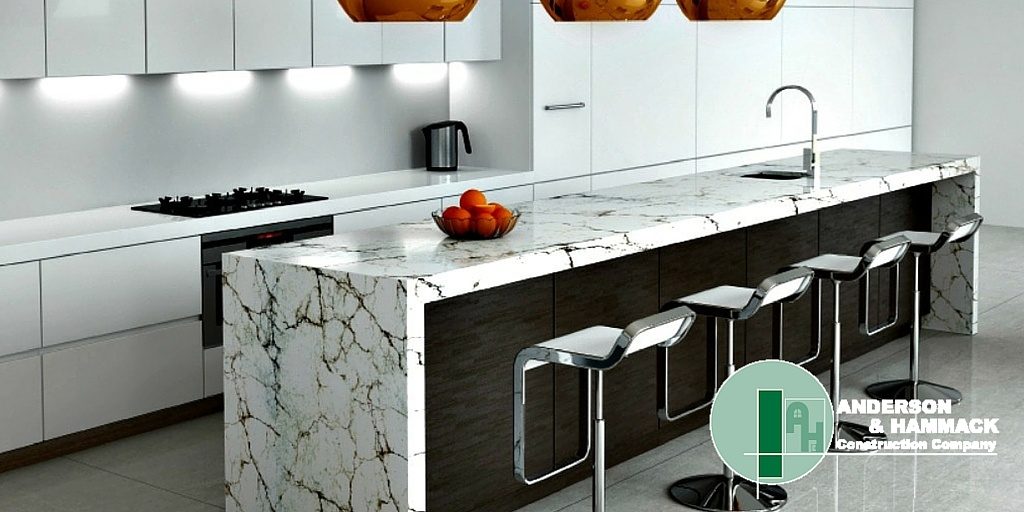
Ultra Compact Countertops
The term “ultra compact surface” is used to describe a completely new countertop surface that is made by putting the raw materials found in glass, porcelain, and quartz, under extreme heat and pressure to create and almost indestructible material. Ultra compact surfaces were created as an improvement to other countertop surfaces like quartz (Silestone®), granite, marble, and solid surface (Corian®).
What makes ultra compact surfaces almost indestructible? It’s the extreme heat and pressure in the manufacturing process, and when we say “extreme” heat and pressure we mean it. Ultra compact surfaces are typically baked at 2191º Fahrenheit (that’s 1200º Celsius), and compressed at 5900 pounds per square inch. In fact, the press that the makes the product Dekton® byCosentino® is the largest press of its kind in the world at 25,000 tons.
Quartz countertops like Silestone® and Cambria® were the most durable materials available before ultra compact surfaces came along. In fact, Consumer Reports magazine has consistently rated quartz countertops as the best overall choice since 2005. However, when Consumer Reports does their next ratings, ultra compact surfaces should most certainly reign supreme as the best overall.
Also, the extreme manufacturing process used to make ultra compact surfaces makes the product stain and scorch proof. Yes, I actually used the phrase “scorch proof,” not “scorch resistant.” What’s the big deal with the phrase “scorch proof?” Well, ultra compact surfaces like Dekton® are made by large companies like Cosentino®. These large companies make thousands of slabs each year, and do not take on massive potential liability for making promises they can’t keep. Normally you will see the phrase scorch or stain “resistant” used by large companies. The word “resistant” gives them a little wiggle room to get out of liability if the material stains or burns. However, the phrase “stain proof” means it won’t stain or it will be replaced- no matter what. These are big promises, but ultra compact surfaces are the most durable countertop products on the market and can be used indoors or outdoors without worry. Can you imagine a company saying it will warranty a countertop product for 10 years when it is installed in an outdoor kitchen in Minneapolis, MN where temperatures vary from 100º Fahrenheit in summer to -40º below zero in winter? The exposure is extreme, but ultra compact surfaces can take it.
Now it is true that ultra compact surfaces are only “scratch resistant” not “scratch proof” because they can be scratched by diamonds, but I doubt anyone in their right mind would make a countertop out of diamonds just to make the “scratch proof” claim. However, if you’re looking for something new and different to use as countertops, flooring, shower walls, or anything else in your home, ultra compact surfaces will out perform any other material.
Pro’s
Resists damage from heat, stains, chopping and cutting and is very good at resisting abrasion.
Con’s
The recommended thickness by the manufacturer’s is 2 centimeters thick, however in tests conducted by consumer reports on one of the popular brands, resulted in cracking and chipping when met with impacts of dropping a heavy pot from 2 feet above the counter.
Download Our Free Countertop Comparison Guide Here
Soapstone Countertops
Homeowners who want an exquisite and exclusive product in their home are choosing soapstone countertops over granite and other natural stone surfaces.
Soapstone Facts
- Soapstone does not stain.
- Soapstone counters are not harmed by hot pots, citrus, wine, acids or chemicals.
- The only maintenance recommended, not required, is the mineral oil treatment to enhance the natural darkening process the stone goes through and to ensure the soapstone darkens evenly. Mineral oil is not recommended to protect the soapstone, it does not need protection since it is naturally non- porous.
- Cleaning your soapstone tops can be done with any of the common household cleaners, no need to buy special sealants or other “hard to find” often harsh chemicals.
- The cost of soapstone is comparable to other natural stones.
Soapstone can be offered in a variety of different textures, unlike most other natural stones that are only available with a high polished finish. Some clients like the stone to feel rougher to the touch, others like it a little smoother and some like it in between, we can please all tastes by re-finishing the top of the slabs, at no additional cost.
Natural Soapstone
Untreated soapstone results in shades of light gray. If you choose this option, you will eventually get oil and other spills on the soapstone. That will darken the soapstone in spots, but will not stain it, since soapstone is non-porous. You can either clean it a common household cleaner or you can use a household steel-wool pad to clean that spot. Remember, anything that you get on the soapstone surface will not penetrate the stone.
Aged Soapstone
This is many people’s favorite look. When you first oil the soapstone, because the oil won’t penetrate, it will eventually fade, and eventually return to it’s original light gray color, or very close to it. In order to achieve the aged look you can oil the soapstone once or twice and never oil it again. It will have that aged, charcoal look.
Oiled Soapstone
If you like the deep rich color of soapstone and love to see the prominent natural veining then the oil soapstone finish should be your choice. To achieve this look you will need to apply periodical coats of mineral oil to the stone until it develops a permanent patina. You also have the ability to reverse this look by removing the mineral oil.
Pro’s
Best for adding the beauty of stone to a low-traffic kitchen. It withstands heat very well and small scratches can be repaired. Slabs vary, visit a stone yard and pick the piece you love.
Con’s
But it’s easily sliced, scratched, and nicked. Stain resistance is so-so and it needs to be periodically rubbed with mineral oil.
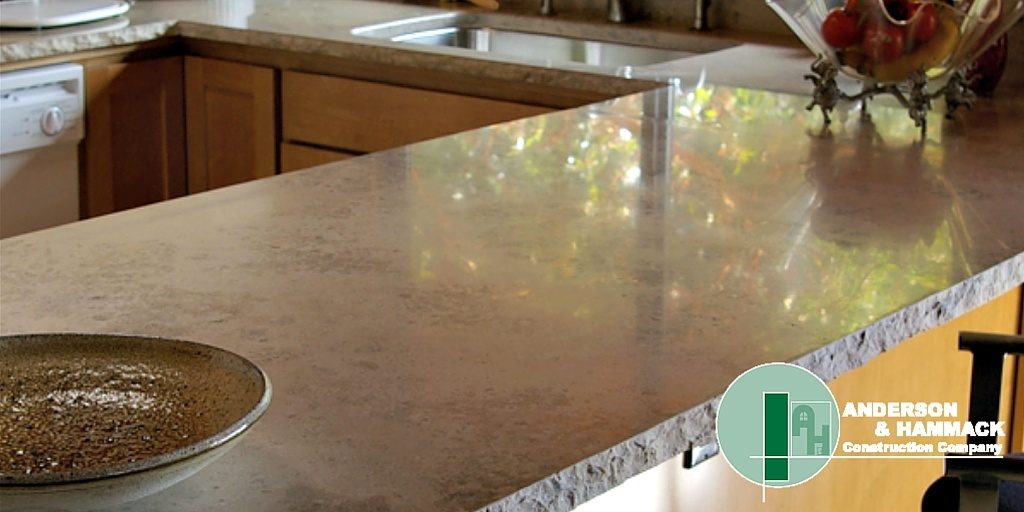
Limestone Countertops
While limestone is an attractive, heat-resistant choice for kitchen countertops, compared to other natural stone countertop options, such as granite and marble, limestone requires significant upkeep. Limestone is more porous than other stone, and usually light in color, so is more easily stained. However, when you know how to properly care for your limestone countertops, they make an affordable and sophisticated upgrade for your kitchen.
Sealing
Limestone absorbs liquids and easily stains, especially when acidic foods, come into contact with the stone. When you install your limestone countertops, they should be professionally sealed. After that, limestone countertops should be sealed at least once a year to prevent staining. While no sealer is 100-percent effective at keeping stains from seeping into your limestone countertops, water-based sealants offer the most protection. Specific cleaning sprays that contain sealing properties may be used on a weekly or monthly basis for added protection.
Cleaning
Limestone countertops should never be cleaned with traditional kitchen cleaners. If you cannot find a cleaner designed specifically with limestone countertops with a cleaner that has a neutral pH or a mixture of warm water and mild detergent. Never use any sponges or other cleaning supplies with rough surfaces when cleaning because they have the potential to scratch the countertops. A soft rag or washcloth works best.
Scratches
Limestone countertops scratch easily. Avoid scratches by using cutting boards when using knives and placing dishes and utensils that could potentially scratch the countertops on trivets or place-mats. If you find small scratches in your limestone, lightly buff them out with a fine steel wool. You may also use a small amount of polishing compound, designed to take scratches off car doors, or grout on the scratch.
Discoloration or Staining
With limestone countertops, all spills must be wiped up immediately to prevent staining. Limestone countertops are particularly susceptible to stains from acidic liquids, such as lemon juice or black tea. Hot pans may also create stains by burning or scorching the limestone. Remove stains by making a simple poultice from flour and hydrogen peroxide. To make the poultice, mix 1 cup of flour with 2 to 3 tablespoons of hydrogen peroxide. You may also use a store-bought poultice.
Other Considerations
If you can, consider the care that goes into limestone countertops before you choose to install them and make choices to minimize the amount of care and cleaning you have to do. Choosing limestone countertops with a matte, or honed, finish instead of a polished finish reduces fingerprints and make any scratches or buffed out stains less noticeable. Lighter colors of limestone shows fewer scratches and texture damage, while darker limestone hides more stains.
Pro’s
Limestone resists heat well.
Con’s
Scratches and dings from our dropped 5-pound weight marred the surface of this soft, porous stone, and even a high-quality sealer didn’t protect against stains. Eleven of the 20 substances we applied left stains still visible after they were left on the surface for just 24 hours.

Bamboo Countertops
Bamboo is a pretty remarkable material and bamboo countertops are just one example of this material’s versatility. If you’ve been trying to find an alternative countertop material that looks unique but still offers good functionality, bamboo might be a good choice.
The key to success with bamboo countertops however is understanding that they’re not made from a homogeneous slab of bamboo but rather, an “assembly” of sorts of pieces of bamboo, much like plywood is a fusion of several layers of wood. It’s also important to know that bamboo material has different characteristics based on how it’s constructed.
There are other points to consider about bamboo like matching the right finish to the intended purpose and making sure it’s installed properly. Bamboo has a lot of great attributes and while it makes for a good countertop choice, it’s not just an ‘install-and-forget’ kind of material.
Take a few moments to become familiar with bamboo and how it’s used to make countertops. That will help you make an informed decision about whether it’s the right choice in the first place and which type and style suits you best.
Read on to learn more and see if it’s a good match for your taste and needs.
What You Should Know About Bamboo Countertops
To understand whether bamboo is good choice for a countertop material you first need to first understand something about the material itself. It’s versatile, strong and beautiful but it also has some unique characteristics that govern how it’s “put together” into a countertop surface.
Important Facts About Bamboo’s Construction
Bamboo material, particularly in the form that’s used for countertops, looks, feels and responds like wood. To be technically correct however, it’s not wood but a form of grass.
The key point to understand about most things made from bamboo is that as a building material, bamboo is an “engineered” product. It’s an ‘assembly’ of sorts of many pieces of bamboo that are glued together to form boards and panels, similar to how plywood is made.
The reason for this is because the bamboo plant’s “trunk” (actually known as the “culm”) is hollow. There’s no way to extract wide or thick boards of bamboo like you can with large trees. Instead, the walls of the culm are sliced into strips and then glued together in various configurations to make the boards and panels used for things like countertops, cabinets and flooring.
Pro’s
Best for show rather than daily use. It’s available in several styles, including a parquet pattern.
Con’s
But it’s easily stained, scorched, sliced, and nicked. Ask if you can use near a sink because moisture can warp it, and note that bamboo may darken over time.
Download Our Free Countertop Comparison Guide Here
About Anderson & Hammack
Anderson & Hammack is a premier home builder & remodeler in the Duluth, MN & Superior, WI area. Specializing in green building, we strive to assist our clients through the building process, providing reassurances through informed material decisions.
In the last 25 years, Anderson & Hammack has helped provide our community a proven resource for building and remodel projects, ensuring reliable processes and assistance from beginning to end. Knowing our clients are our best resource for company growth, we strive for excellence at every turn of a project, regardless of size.

